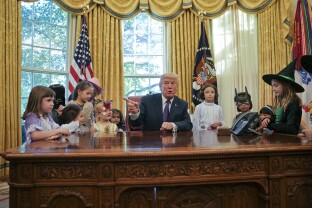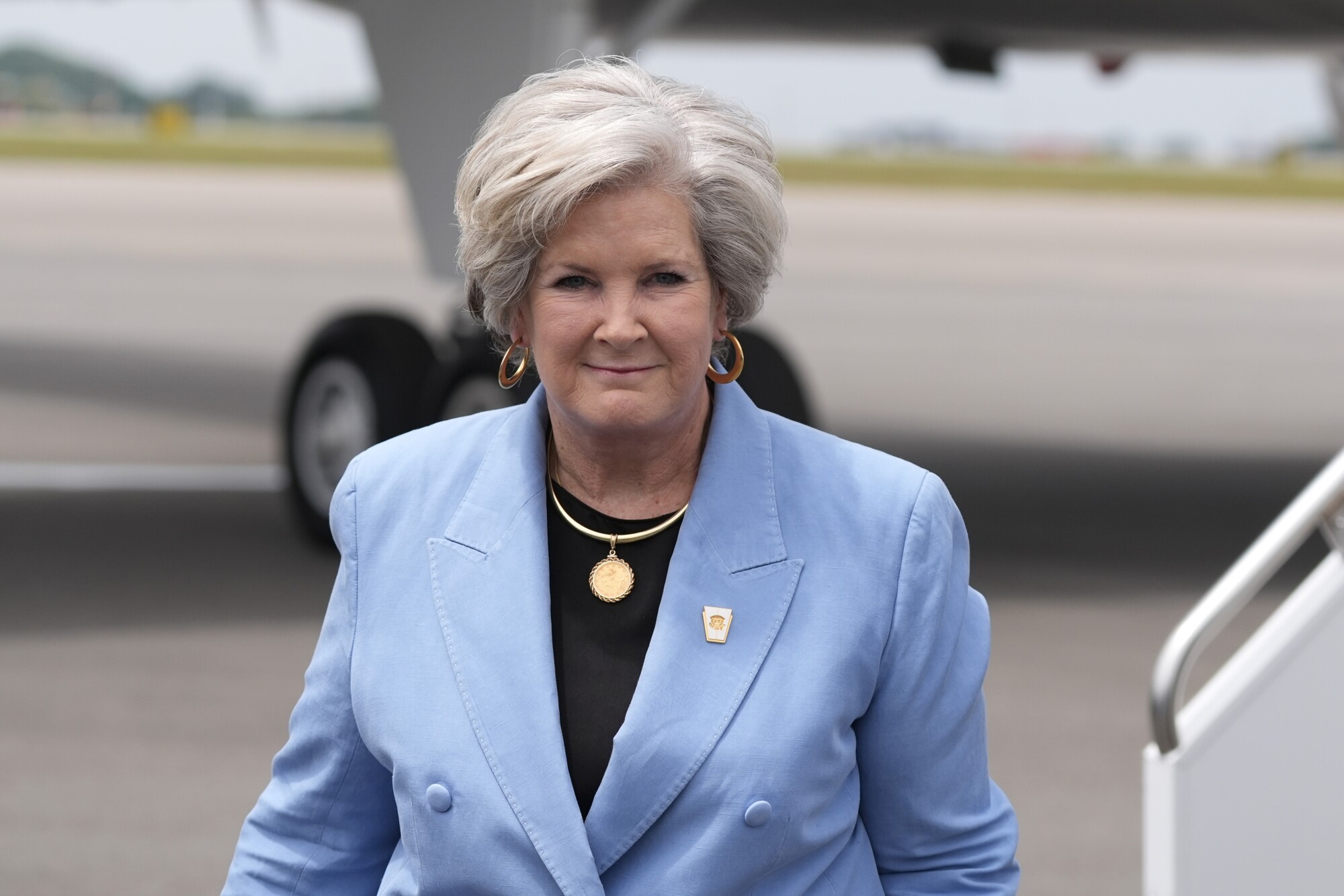About six miles away from Mar-a-Lago, Donald Trump’s lieutenants and wannabe lieutenants have spent weeks working to avoid the fundamental error that derailed the first MAGA presidency: a trifurcated White House staff complete with warring factions and middling allegiance to Trump and his agenda.
“I think that one of the things that plagued the White House in 2017 was kind of three competing power centers,” said Marc Short, the former chief of staff to Trump’s first vice president, Mike Pence. “It seems that this time, there’s more unity and purpose and mission with the team that’s been assembled.”
Nearly a dozen Republicans, party officials and former and current Trump officials familiar with the transition process told NOTUS that the goal is not just loyalty, but something that every president hopes to enjoy. It’s weeding out those who would protest Trump’s agenda, no matter how controversial it may become.
“2016 and 2024 are night and day,” a former Trump administration official said.
In 2016, after Trump’s surprise win, few people in the transition knew what it took to run a federal office, no less the White House. Staff have since told stories about being unable to find the light switches in various executive rooms. They say the amateurishness created a leadership vacuum that let the Republican National Committee members — led by Trump’s first chief of staff, Reince Priebus — rush in.
The result was a divided White House: one side with Trump originals from the campaign peppered in with Steve Bannon types, another with RNC members and a third made up of left-leaning officials from New York like Trump’s son-in-law Jared Kushner.
“You’re up against people that are in high-level positions that thought they had all the answers, and then you’re spending more time debating them to execute the policy that the president told us to execute [while] they’re over here telling us why it’s not a good idea,” a second former Trump official said, specifically citing the former national security advisor John Bolton, who drew headlines for his clashes with Trump. “It’s like, dude, you’re not the president of the United States. You got to serve too.”
The goal now is to change all that. The process now overseen by Trump’s incoming chief of staff, Susie Wiles, allies and officials tell NOTUS, is intentionally set up to limit infighting — even if factions are still around.
“I think the factions exist,” a Republican official told NOTUS, noting all the different outside coalition groups like America First Policy and The Heritage Foundation. “I think there’s just a lot more of a process to basically prevent people from just making a mess of it all.”
A spokesperson for the transition did not respond to a request to comment for this story.
Aides who were part of the 2016 transition team, and those watching from outside, have already seen a substantial difference in how Wiles is crafting the new White House.
“She’s just very, very structure-oriented,” one person close to the transition said. “She very much prefers the behind-the-scenes aid versus the on-camera.”
Some Republicans describe a corporate-style pyramid structure with Wiles at the top instead of the horizontal organization that existed in 2016. Wiles’ former Florida aides — like incoming deputies Taylor Budowich and James Blair — along with longtime Trump aides Stephen Miller and Dan Scavino, will have a sizable power they can wield in her name. One former official jokingly likened them to her “Four Horsemen.”
It will be a more “senior hierarchy,” they said, comparing it to 2016, where all ranks had relatively easy access to the president and could walk into the Oval Office mostly unrestricted — sparking jokes among officials that any badge could get you access to POTUS.
Those who are involved or aware of transition movements say the staffing work is happening at a more glacial pace than last time around, with more deliberate and cautious searching for agency staff and undersecretaries.
Still, the slowness has not dulled the jockeying. Calls have flown between members of Congress to Wiles or other transition officials.
“You basically just blast around [a name] until you get a response, and then you make sure they apply on the inside, and then you follow up weeks later, and you keep on pushing,” one outside ally who has helped people get interviews said. “I haven’t heard of a better way to guarantee anything.”
Affinity groups that helped Trump get elected have sent over lists. The official transition website now has a landing page titled “Serve America,” which warns that with any job you choose, “time commitment is significant and the pace is fast.”
The 2024 campaign officials, well-liked in Trump’s orbit, are generally getting first picks of the White House positions, three sources familiar with the transition told NOTUS. One person said staffers were asked to submit résumés along with three positions they would want in the new administration, and the powers that be would try to match the best-suited request.
It’s typical for new White House leadership to reward the staffers who put them there. But that’s not what initially happened in 2016, when Trump fired his original Chris Christie-helmed transition team and the Priebus RNC barged in, resulting in many of the original Trump staffers feeling left out of the process and waiting for months to hear about jobs.
“I do know that a lot of campaign/staffers felt we did all the hard work only to have the RNC (who openly hated & fought against DJT getting the nomination) swooped in post-convention” and “took over,” one campaign staffer texted NOTUS. “But as the old adage says, ‘Fool us once.’”
Sergio Gor, a longtime Republican aide who ran the publishing company that put out Trump’s books, was tapped in November to lead the personnel office in charge of staffing most of the 4,000 political appointees across the administration. In June 2017, Trump’s first year in the White House, they employed 377 people in the executive office of the president. By June 2020, that number ballooned to 412.
Donald Trump Jr. told The Washington Post that Gor’s task will be to establish who will actually be loyal. “He will diligently go through and understand not just where were they in 2015 and 2016, but where were they on Jan. 7,” he said, describing the day after the 2021 riot at the Capitol. “What were they doing and saying at that time?”
Another Republican official told NOTUS that Gor would have to be the one to “bridge those factions” that could get unruly if pitted against one another.
Other top staff in hiring meetings include Blair, the incoming deputy chief of staff for legislative, political and public affairs; Miller, the incoming deputy chief of policy and homeland security adviser; and Budowich, the deputy chief of staff for communications and personnel.
“There’s this sense of ‘we have a lot of authority to go ahead and do what Susie has asked us to do,’” said one person familiar with the interview process. “But we don’t want to be in a situation where we have to look her in the eye and say, ‘We failed you because we didn’t do our due diligence.’”
Trump has already announced much of the senior staff that will fill out 1600 Pennsylvania Ave. But those rungs lower remain vacant.
To staff up hundreds of lower-level jobs, the Trump transition team has started using the job bank created by Project 2025, according to a source close to the transition — a reversal from the campaign, when Trump and his top aides swore off the group and threatened anyone associated with it with banishment.
Some campaign staffers turned prospective applicants have been told they will have a position inside the White House, though they’ve been given little to no clarity on what those jobs will actually be. Others have been told they’ll hear whether they will be joining at all in January.
“There’s growing frustration among the would-be’s,” said one of those Republicans. “There’s only three weeks left til inauguration and some people are trying to figure out what their future is going to look like with no clarity.”
After those who worked for the campaign, some believe the second rung of priority for staffing is people who worked for or are close to the Trump family, and next are those who work for the America First Policy Institute, the prominent right-wing think tank that’s been central to planning Trump’s term and has retained power in the MAGA movement. One person close to the group guessed that if AFPI hypothetically had 100 members of their staff, at least 60 are planning to go into the administration.
“They did the work during the off year, AFPI … to ensure that a lot of those pitfalls in terms of loyalty, that we didn’t run into the same thing,” one Republican official said. “And so I think we’re totally at a completely different playing field than 2016.”
AFPI toiled away, flying under the radar for years, to build a bench and policy agenda ready to unleash if Trump were to retake the White House. Multiple cabinet nominees — like Brooke Rollins, the agriculture secretary nominee, and Linda McMahon, the commerce secretary nominee — and other senior officials hail from it.
During the campaign, AFPI was part of a series of calls with right-leaning coalition groups spanning from religion to race and often included Trump officials like Alex Latcham, who is set to return to the White House as a deputy assistant to the president and director of the Office of Public Liaison. The calls were in part intended to encourage those groups to send the transition team lists of who they’d want to put forth for the White House.
The efforts to carefully organize, laid out over months, are underway. But as has always been true for Trump, it’s an open question of how long it’ll stick.
“I think they’re trying to create a structure in which there’s more of a hierarchy for information to proceed up to the president than what we had before,” a former aide said. “Now I am very skeptical that that will last, because just having worked with the president, he has a huge appetite for information, and he likes to talk to multiple people. He doesn’t like hierarchy.”
They added, “This corporate structure that sounds great on paper. I just don’t know that it’s going to actually last.”
—
Jasmine Wright is a reporter at NOTUS. Reese Gorman contributed reporting.
Sign in
Log into your free account with your email. Don’t have one?
Check your email for a one-time code.
We sent a 4-digit code to . Enter the pin to confirm your account.
New code will be available in 1:00
Let’s try this again.
We encountered an error with the passcode sent to . Please reenter your email.



